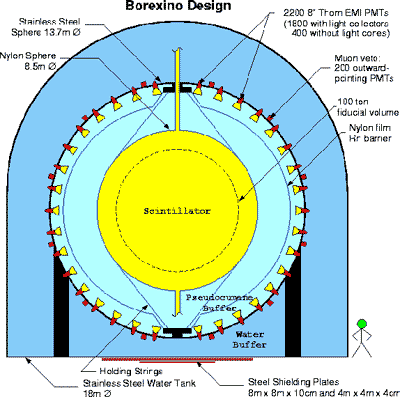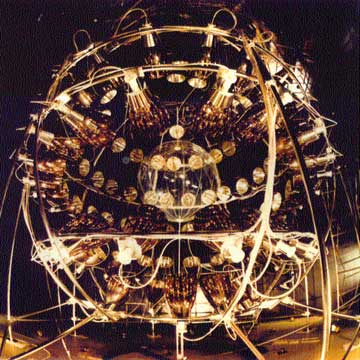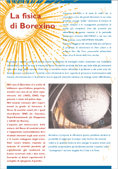Borexino is a particle physics experiment located in the Hall C of the Laboratori Nazionale del Gran Sasso, in central Italy. Its main goal is the study of the properties of a subatomic elementary particle, called the neutrino.
Subatomic particles play a major role as building blocks of the ordinary matter that surround us; protons, neutrons and electrons are the main constituents of the atom. Inside the atomic nucleus, protons and neutrons are kept together by the Strong Nuclear interaction, while inside the atom the nucleus and the electrons are bound by the Electromagnetic interaction (see Table 1).
Table 1 – A few typical structures of the subatomic world.
|
Structure |
Constituents |
Binding Force among constituents |
|---|---|---|
|
Proton |
Quarks |
Strong Nuclear |
|
Nucleus |
Protons and Neutrons |
Strong Nuclear |
|
Atom |
Nucleus and Electrons |
Electromagnetic |
According to modern Quantum Theory, each of the four main interactions (Strong Nuclear force, Electromagnetic force, Weak Nuclear force and Gravitation) is transmitted by means of a quantum, an elementary particle acting as a carrier of the interaction. One of these carriers is the photon, the quantum of the Electromagnetic force.
However many other particles,
in addition to protons, neutrons, electrons and photons play a decisive role
in the subatomic world. One of these particles is the neutrino, which is emitted
in the so-called Weak Nuclear interactions. Table 2 displays some characteristics
of three common subatomic particles.
Table 2 - Subatomic particles and force to which they are subjected.
|
Particle |
Strong Nuclear (carrier: gluon) |
Electromagnetic (carrier: photon) |
Weak Nuclear (carrier: W, Z) |
Gravitation (carrier: gravitation) |
|---|---|---|---|---|
|
Proton |
Yes |
Yes |
Yes |
Yes |
|
Muon |
No |
Yes |
Yes |
Yes |
|
Electron |
No |
Yes |
Yes |
Yes |
|
Neutrino |
No |
No |
Yes |
Yes |
Weak Nuclear interactions are important in regulating the energy-generating processes that take place at the center of the Sun as well as in radioactive decays of unstable nuclei. These interactions typically emit neutrinos.
Another place where neutrinos play a decisive role is the Universe itself, which is literally filled of neutrinos. The ultimate fate of the Universe depends on the velocity of expansion (Hubble’s constant) and on its density (or total mass). If the neutrino had a mass it could play an important role in determining whether the Universe is heading for a Big Crunch (as opposite to the primordial Big Bang) or for indefinite expansion.
Everything we know about the subatomic world is encompassed in the so-called Standard Model. The Standard Model of the elementary particles is a very general framework that allows the interpretation of a huge amount of data collected over all the century in cosmic rays studies, underground laboratories and (predominantly) accelerator experiments. One of the most important successes obtained in the course of the development of the Standard Model was the unification of the Weak Nuclear Force and Electromagnetism: the Electroweak theory.
In spite of these successes, the Standard Model has serious problems as a candidate for an ultimate theory of the subatomic particles. Among other things, it does not include Gravitation and it does not give a satisfactory explanation of the actual number and masses of the particles.
Neutrino properties provide an important avenue to physics not included in the Standard Model and can trigger important revisions and improvements of the theory. In fact in the Standard Model the neutrino is strictly massless, like the photon. The discovery of a non-zero neutrino mass, besides having dramatic cosmological implications, would be of extreme interest as a first indication of physics beyond the Standard Model.
The study of the neutrino – its mass and properties – is precisely the goal of the BOREXINO experiment. For this purpose and extremely intense source of neutrinos is exploited: our Solar System star, the Sun.
The Sun is essentially a self-confining highly efficient nuclear fusion reactor whose production rate is regulated by the Weak Nuclear interaction. A typical fusion reaction, called termination, taking place in the Sun can be written as:
in which four protons are used to form an α particle and two electrons. Two neutrinos (n) are emitted and energy is released (actually 26 MeV, mega-electron volts per one of these reactions).
It is clear from the above reaction that the Sun emits neutrinos. It is a very powerful source indeed: about ~ 6 x 1010 neutrinos of solar origin hit a centimeter square of the Earth per second.
The fusion processes that generate the sun energy take place in the core, the innermost part of the Sun. Lots of photons and neutrinos are produced there. While photons are stopped in the Sun core and the relative energy takes typically a million years to reach the Sun surface (and us), neutrinos emitted in the fusion reactions are able to traverse the material of the Sun (mostly ionized hydrogen and helium) and arrive in 8 minutes (travelling at the speed of light) to the Earth surface. This is possible because of a feature that makes the neutrino peculiar in yet another sense: its interaction capability with matter (called cross section) is unbelievable small (~ 10-46 cm2), so that most of the neutrinos traverse the Sun and the Earth with almost no interactions at all. Superdense neutron stars and black holes are presumably the only objects in the Universe that are capable of effectively trapping neutrinos.
The reason for this can be found in Table 2: unlike the proton and the electron (or the photon) the neutrino is totally insensitive to Strong Nuclear and Electromagnetic interactions (by far the two strongest forces), being only responsive to Weak Nuclear interactions (and of course to Gravitation).
Now a question comes naturally about: how is it possible to study neutrinos given the fact that, in order to absorb a neutrino, 100 light-years of an ordinary material (like water) would typically be needed? 1 The answer lies in the fact that neutrino absorption is a statistical process: a few neutrinos (very few!) can interact even in a small amount of material. They key to neutrino detection is in fact having very many neutrinos impinging on your experimental setup.
It is precisely inside a huge detector like BOREXINO that an impressive compensation takes place between an unbelievably small number (the neutrino cross section, 10-46 cm2) and an incredibly large number (the solar neutrino flux, ~ 1010 cm-2 sec-1) to produce a number which is still rather small (~ 10-36 interactions per second per unit target) but can be made reasonable by having a big (several tons) detector (tons of material, so that one has ~ 1030 targets).
Therefore, in spite of the elusiveness of this particle, experiments are being made to determine its properties. An important experimental feature is a big detector mass, so that many targets are available for neutrinos to interact. BOREXINO is no exception in this sense. The detector (figure 1) features 1300 tons of scintillator and 2400 tons of water.

Figure 1: Schematics of the Borexino detector. The external shielding of Water (Water Buffer, 2400 tonnes) surrounds the photomultiplier sphere, which in turns contains 1300 tonnes of liquid. The 300 innermost tonnes of this liquid (Scintillator) constitute the sensitive volume of the detector: they consist of an aromatic-based liquid scintillator.
A scintillator is a material that emits light when it is traversed by a subatomic charged particle, for instance an electron.
The detection of neutrinos in BOREXINO is made by using electrons of the liquid scintillator as the target, according to the following the reaction:
in which the neutrinos hit the electrons of the material. While the electron on the left-hand side is practically at rest, the one on the right hand side has received energy from the impinging neutrino and is therefore able to generate a scintillation signal (composed by light) within a special liquid material, called scintillator (see figure 1). This light burst is then detected by the 2200 photomultipliers of the detector, which essentially are light sensors. In short, the detection of light pulses by the photomultiplier system signals the interaction of a neutrino.
Figure 2 shows an impressive view of the BOREXINO prototype: the scintillator material is enclosed in the balloon at the center of the picture (which has a diameter of 2 meters) in which also the photomultiplier system (and support structure) is visible.

Figure 2 – The BOREXINO prototype viewed from inside the water tank. The scintillator is contained in the nylon balloon at the center. A stainless steel structure supports the photomultipliers. Everything is immersed in ultrapure water.
Unfortunately this is not the whole story. There is a very important experimental problem that makes neutrino detection even more difficult: background.
The background has several components, but the main are (in general) radioactivity of the materials and cosmic ray particles. They generate interactions and release electrons in a detector like BOREXINO; those would be false signal that can be erroneously interpreted as neutrino signals. Given that, if no precautions were taken, the background will be about a billion times the neutrino signal, the difficulty of the experimental problem is readily appreciated.
The cosmic rays background practically imposes the use of an underground laboratory that would shield the detector. Gran Sasso is ideal from this point of view since it has a natural shielding of about 1.4 km of rock, which is very effective at stopping cosmic rays. For instance, subatomic particles called muons would arrive on the detector from the space with a rate of about 1 million muons per hour per square meter, while in the Hall C of Gran Sasso, where BOREXINO is located, this rate is reduced to only one muon per hour per square meter.
The other critical factor is the radioactivity present in Gran Sasso itself and the intrinsic radioactivity of the BOREXINO detector. Both factors have been thoroughly studied and several measures are taken to minimize them. For instance, the innermost part of the detector (which is also the sensitive volume, containing the liquid scintillator,) is shielded by a big mass of ultrapure water; everything you see in fig. 2 is immersed in ultrapure water. The picture was actually taken from inside an 11 m diameter water tank.
The final important step consists in the reduction of the radioactivity of the scintillator itself, the core of the BOREXINO detector. To reach this goal several radiopurification techniques were developed by the physicists, chemists and engineers of the collaboration. The BOREXINO experimental program has been the first to demonstrate radiopurities at levels of 10-16 gr/gr of Uranium in big masses (tonnes) of liquid material. This radioactive contamination is more than a million times lower than the one of everyday-life liquids.
In conclusion, the main experimental program of BOREXINO consists in the study of solar neutrinos, taking advantage of the high purity of the detector, its effective shielding and the sensitivity of the photomultiplier system. The detector can provide a decisive insight into problems such as the mass of the neutrino, one of the most important indicators of physics not included in the Standard Model of the subatomic particles.
BOREXINO is performed by an international collaboration featuring about 70 scientists from Italy (INFN and Universities of Milano, Genova, Pavia, Perugia and Laboratori Nazionali del Gran Sasso), France (College de France), Germany (TUM Münich, Max-Plank Heidelberg), Hungary (KFKI Budapest), Russia (JINR Dubna, Kurchatov Institute Moscow), and the United States (Princeton University, MIT, Lucent Technologies, Virginia Tech.).
The main funding agencies of the experiment ate the Italian Istituto Nazionale di Fisica Nucleare, the American National Science Foundation and the German Bundesministerium für Forschung und Technologie.
1 For comparison, the Solar System has a diameter of only 0.001 light years, only 1010 km.

